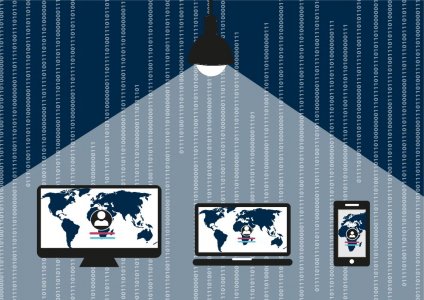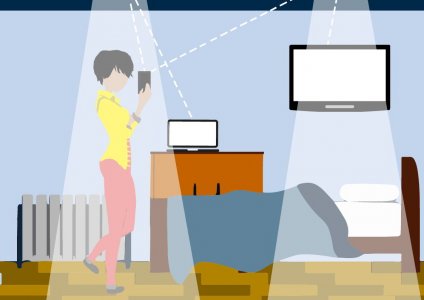In places where large numbers of people are using the internet and WLAN at the same time, this inevitably results in bottlenecks in the access network. Wireless network capacities reach their limits and I find I know the majority of my immediate neighbours through the Wi-Fi list on my devices. Reinforced concrete walls naturally reduce data throughput. Furthermore, networks are often unencrypted, meaning that much of the data can easily be hacked and read by all and sundry. Research is being done at academic level to develop a standard for the transmission of data that will solve all these problems: visible light communication or Light Fidelity, in short Li-Fi. And apparently there are – how could it be otherwise – many completely different forms of optical data transmission. One team of researchers at Oxford University even managed to transfer data via light at bi-directional speeds of 224 Gbit/s by transmitting six different wavelengths.
For more than a decade, various scientific institutes, including the Fraunhofer Institute for Photonic Microsystems (IPMS), have been pursuing research on future potential data rates using optical wireless communication solutions, to eventually replace conventional electromagnetic Wi-Fi. In October 2011, a consortium comprising four institutions was formed to work on this very topic. In the meantime, researchers have begun working on an industrial solution based on Li-Fi technology, and have already succeeded in achieving a transmission rate of 12.5 Gbit/s. In 2016, the Edinburgh-based company pureLiFi, which German IT expert and Li-Fi pioneer Prof. Harald Haas is involved in, introduced LiFi-X, the world’s first Li-Fi dongle that marks a crucial step towards mass-market adoption.
Instead of using traditional radio frequency signals, such as an antenna on a wireless router, Li-Fi uses LEDs, which have been applied to provide lighting anyway. The light emitted is the transmission medium for the data. At very high frequen- cies, the data can transmit signals to the photocell – the receiver – in the end device. Given the high switching frequency, this all remains invisible to the human eye. Given the continuously changing intensity the transmitter is working at, binary data can be transmitted. But there is more to this than (literally) meets the eye: data first needs to be split up onto different carriers (LED sources), for example. So far, so good!
Does Li-Fi also work in the dark?
The plan is to use energy-saving infrared light for the return channel. This cannot be perceived by the human eye. Interference can be purposefully avoided. This occurs under certain circumstances when two electromagnetic waves with similar or the same frequencies overlap or clash.
To enable the system to function properly, the transmitting LED needs to be active the whole time. Li-Fi does indeed work even at night: the light sources are dimmed down so low that the user of the space no longer perceives them as a source of light.
The usable wireless spectrum is growing
Technically speaking, the visible light that we humans perceive is as much comprised of electromagnetic waves as radio waves. The frequency in the Terahertz range is, however, substantially higher than the centimetre waves used in the GHz range. The disadvantage: electromagnetic radiation such as light, which is measured in nanometres, cannot penetrate dense matter; every obstacle in its path limits its range or coverage. Although this can also be interpreted as an advantage: given that light waves fail to permeate even the smallest obstacles, it is possible to seal the network off by providing simple spatial separation. This can be a plus point for companies when it comes to data protection. In closed rooms, internal data traffic cannot be accessed or read without authorisation. It is, however, still possible to intercept data packages by redirecting them optically.
A further advantage: the spectrum is far broader than that of radio waves. This enables individual users to achieve higher transmission rates, and trouble-free operation is guaranteed. The visible light spectrum is unlicensed; anyone can use it.
Simply modify the ceiling light
And a lot speaks for the technology itself. In order for it to work, the existing infrastructure only needs to undergo minor modifications. An encoder is integrated into the light source, and the appliance will then need a receiver to be able to capture the light waves. The electricity supply is via the mains. The technology consumes slightly more energy than the light source itself.
Communication from a central internet connection for the network to the diode in the transmitter can also be established via an existing system: the power supply. The LED transmitter, that is to say the light source, receives the signals directly via the power supply. Very little additional energy is required to convert the signal in the encoder.
There are still issues that remain unsolved
In general, the technology does still have some problems to deal with. A line of sight between the transmitter and the receiver must be ensured. The tiniest malfunctions render the connection unusable and disrupts the communication. Since the technology cannot penetrate walls, every space must be equipped with the technology required for data transfer and it must be guaranteed that the different channels switch synchronously when the user changes rooms.
The technology is not mobile: if the user moves the end device so that the sensor is directed away from
the sensor, connection will be interrupted. In some cases, this may not happen, but the performance will be so poor that communication practically breaks down. To solve this problem well-engineered all-round cells are necessary.
In addition, at high transmission rates light is highly susceptible to disturbances in the earth’s atmosphere, for example if light rays are deflected by gases or microparticles. The longer the distance the light needs to overcome, the more rays are absorbed or refracted. This in turn undermines the stability and reduces the speed. Consideration must also be given to any reflections that may potentially occur, also in mirrors in the space. If the interval between two signal transmissions is greater than the delay or shift caused by the reflection, any transfer of data will be poor.
Li-Fi cannot replace Wi-Fi in any application scenario. In the case of driver-assistance systems, this could be very dangerous; a minimal obstacle or the slightest soiling of the photoelectric cell would partially or completely disrupt communication.
Solar cells can receive data
Li-Fi pioneer Prof. Harald Haas, who introduced Li-Fi as a concept where "light can transmit data" in 2011, presented a functioning transmitting/receiving system for the first time at the Mobile World Congress (MWC) 2016 in Barcelona with his company pureLiFi. The LiFi-X module, as it is known, enables a data transfer rate of 40 Mbit/s with synchronous up and download.
In the case of longer communication routes, laser technology can be used. By installing a base station for optical data transmission in geographically higher locations, for example, billions of people would benefit from low-cost internet access. Plus the fact that solar cells can generate electricity from sunlight and laser beams.
The technology even works on foggy days
The new technology could also make Li-Fi an interesting proposition for vehicular traffic: in the case of road traffic, cars can be equipped with solar cells to receive data. They would communicate and interact autonomously with other objects in the streetscape. Haas is convinced that the technology would also work in fog, or under similar weather con- ditions. Sufficient light would still be able to get through for the solar cell to be able to detect the modulation of the light. The risk is still high, how- ever, and scepticism is the first hurdle when it comes to testing validity.
What’s next?
Will Li-Fi be able to replace Wi-Fi in the foreseeable future? Probably not. Although this technology could be an attractive option for factory buildings or industrial plants. The benefits for the end user are to date limited. There are currently still too many unresolved problems. In practice, right now there is no real speed advantage apart from in fixed industrial facilities. The broader spectrum does not offset the disadvantages of the low range, and susceptibility to failure is too high. Experts doubt developers will come up with a solution that will meet the standard required for the mass market in the near future.
That said, Li-Fi is highly promising for use in stationary systems. The concept developed by Haas, which involves using Li-Fi in conjunction with solar cells over distances of a few kilometres, indeed makes sense.
How does Li-Fi work in the lighting design context
When it comes to applications designed to be integrated into a specific space Li-Fi initially comes across as being restrictive and yet another aspect that requires attention. Indirect lighting solutions can be a cause of concern for the lighting designer when it comes to guaranteeing network resilience. Moreover, it is not necessarily one of the prime jobs of a lighting designer to go around creating and coordinating networks. Office application would appear to make more sense to begin with. But we now have the situation that office environments are becoming subject to change because the people who work in them perform creative tasks.

